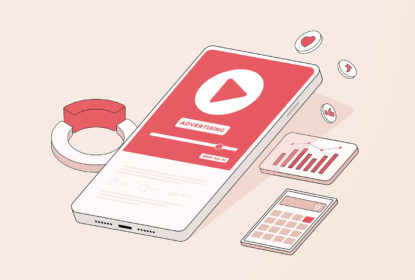When a person walks into your store and asks about a particular product you sell, you might think that they are interested in purchasing that product, only for them to leave without doing so.
Wouldn’t it be nice to have some of your salespeople follow the person around after they leave your store, reminding them of your business and the product they inquired about everywhere they go?
Following someone around might sound like a crazy idea, but that is how remarketing works in the real world. Now, let us take a moment to explore and explain what retargeting (another commonly used word for it) is and how to use it for your business.
What is Remarketing?
Remarketing is re-engaging a current or past customer who has visited your website or webpage, serving them ads based on their previous purchases or actions on your site. It is a very effective way to target people who have shown interest in your business or brand.
Think of this as a second chance for you to convert, up-sell, or retain customers with your ad or campaign.
What are the Different Types of Remarketing?
There are five types of remarketing campaigns that your business can utilize:
- Standard Remarketing
- Video Remarketing
- Email Remarketing
- Dynamic Remarketing
- Remarketing Lists for Search Ads
Each of these campaigns can increase the likelihood of visitors returning to the post-click landing page to perform an action.
In this article, we are going to focus on Remarketing Lists for Search Ads using Google.
Now that we have defined marketing for you, we are going to focus on cost, how it works, and other benefits from a paid campaign standpoint.
What are the Costs?
When running a paid campaign, remarketing is an effective and very cost-efficient way to target and reel in customers who have already shown interest in what you offer.
It works on a cost-per-click, costs per impression, and cost per acquisition model. That lets you fully control how much money you spend on your campaign and make adjustments to your bids.
It is also a great way to increase ROI and ad spend if your budget is limited.
How Does It Work?
Setting up your remarketing campaign for your website is not difficult to do. When you create a campaign using a special ad network, you receive a small code called a pixel tag that you add to your website.
Every time a new person visits your website, the pixel tag will drop a browser cookie, adding the user to your retargeting list. When that person visits another website, the system will serve up your ad to that person. It will continue to do that as long as your campaign is active and running.
What Are Pixel Tags?
The pixel tags I mentioned in the previous paragraph are small pieces of code on a webpage that allow websites to place cookies on them. Every person who visits your website has a unique yet anonymous ID. This ID is how you can track their activity on a website. The Ad server accesses the person’s ID and saves it to your remarketing list.
What is a Remarketing List?
A remarketing list is just a list of website visitors that perform a specific action on your website. Let’s use your homepage as an example. If a visitor visits your homepage, the visitor cookie is added to this list. Here is where you can serve up ads tailored to visitors in hopes they will convert.
Let’s Talk About the Benefits
Below are some other benefits of remarketing:
- Capitalize on lost traffic
- Target visitors who have visited your site and shown interest in what you offer
- Target people who are more likely to convert
- Keep your brand at the top of their mind by putting your ads and business in front of them
- An affordable way to market on a wide range of platforms and channels
- It works in every industry
Your website may be getting a lot of traffic, but only 2% of website visitors convert during their first visit to a website. Well, what does that mean? Even though you’re getting traffic, you are not getting the sale. Here is where remarketing is the best option to capitalize on lost traffic.
Targeting the visitors who have shown interest in your business is the most effective way to remind them to come back to your site.
When You Should Use Remarketing
Many marketers might suggest that to run your remarketing campaign at all times. However, a more advanced method would be to take a personalized approach. Focus your campaign according to predefined criteria.
For example, you run a remarketing campaign only for visitors who view a page (like a product page) or a visitor who visits your website at a specific time of day or year. Again, this all depends on the strategy for your campaign.
You may not see results quickly but make sure that you give your remarketing campaign some time to see results.
Different Marketing Channels
There are different platforms and channels that you can use for remarketing. Here a few below:
- Display Remarketing – This method is one of the most popular types of remarketing. You simply display an ad to people on other sites after they have visited yours, on networks like Yahoo, Bing, and Google.
- Native Remarketing – Re-engage website visitors who have already engaged with your branded content. This is recommended across premium publishers in native ad placements.
- Search Marketing – This method lets you customize your search ads campaign for people who have previously visited your website.
- Social Media Remarketing – Show ads to people on social media platforms such as Facebook, LinkedIn, and Twitter after they’ve visited your website.
Google Recommendations
Google recommends that when you are first starting your remarketing campaign, target everyone who has viewed your homepage. Doing so will increase your costs since your ads are retargeting more people, so you won’t be able to create ads that are as targeted. But this will give you the opportunity to narrow down your retargeting list based on the visitors who clicked on your ad.
From there, you can create different Google remarketing lists for narrower targeted camps. For example, you can choose to show different ads to people who have already purchased from your site compared to people who didn’t make a purchase.
As you can see, remarketing is an excellent opportunity for you and your business to close sales and generate more revenue for your business. If you and your business are interested in running a remarketing campaign, please contact ARYU Advertising, and let us help.










